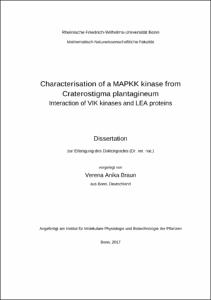Characterisation of a MAPKK kinase from Craterostigma plantagineumInteraction of VIK kinases and LEA proteins

Characterisation of a MAPKK kinase from Craterostigma plantagineum
Interaction of VIK kinases and LEA proteins

| dc.contributor.advisor | Bartels, Dorothea | |
| dc.contributor.author | Braun, Verena Anika | |
| dc.date.accessioned | 2020-04-24T23:25:22Z | |
| dc.date.available | 2020-04-24T23:25:22Z | |
| dc.date.issued | 21.02.2018 | |
| dc.identifier.uri | https://hdl.handle.net/20.500.11811/7499 | |
| dc.description.abstract | Drought is a key factor for yield loss in agriculture. However, desiccation tolerant plant species evolved various mechanisms to protect vegetative tissues from the hazardous effects of drought. These mechanisms are not fully understood and the work in this thesis contributes to the understanding of phosphorylation of stress related proteins in the desiccation tolerant plant Craterostigma plantagineum. In desiccation sensitive plant species MAPKKKs are known to be involved in multiple drought stress response pathways. However, their role in the acquisition of desiccation tolerance of resurrection plants has not been investigated up to now. In the desiccation tolerant plant species C. plantagineum several proteins show drought stress-dependent phosphorylation. The phosphorylation of these proteins was predicted to be partially mediated by MAPKKKs (Mariaux et al. 1998; Röhrig et al. 2006; Röhrig et al. 2008). An in-gel-kinase assay using the stress-related phosphoprotein CDeT11-24 as substrate demonstrated the presence of a MAPKKK in C. plantagineum (Petersen 2012). The identified MAPKKK is a homologue to the RAF-like MAPKKK VH1-interacting kinase (VIK) from A. thaliana (At1g14000) and was consequently named CpVIK. Based on this observation it was hypothesised that CpVIK and CDeT11-24 are functionally coupled and interact with each other. In this study in silico analyses demonstrated that CpVIK belongs to the tandem-repeat ankyrin motif containing MAPKKKs (ANKMAPKKKs) that are widely distributed in various taxa. Based on their early occurrence during evolution already in bacterial genomes and the conservation in plants as well as metazoa, it is assumed that the ANKMAPKKKs have essential functions which are not yet fully understood. Co-immunoprecipitation experiments performed in this work verified a physical interaction of CDeT11-24 and CpVIK. In vitro assays confirmed phosphorylation of CDeT11-24 by the enzymatic action of CpVIK. An increased expression of CpVIK on the RNA and protein level was observed upon abiotic stresses, including dehydration. Phosphorylation of the CpVIK protein revealed to be stress-dependent. CDeT11-24 and CpVIK showed to be co-expressed and the proteins are co-localised in the cytosol. Together with previous findings, showing high expression of VIK orthologs in seeds of desiccation sensitive species, it is proposed that VIK participates in the acquisition of drought tolerance in vegetative tissues of desiccation tolerant C. plantagineum as well as in seeds of desiccation sensitive plant species. In addition to an involvement of CpVIK in drought stress, for most VIK orthologous genes, an increase of gene expression in mature leaves compared to young leaves is observed indicating importance of VIK in later stages of plant development. In A. thaliana plants no phenotypic differences were detected for AtVIK knock-out mutant plants (Δvik) in comparison to wild type plants upon dehydration or salt stress at different developmental stages. However, a lower germination rate of Δvik seeds was observed especially under salt stress conditions. Comparative seed proteome analyses verified aberrant phosphoproteins in Δvik seeds including RD29B, the closest homologue to the CDeT11-24 LEA-like C. plantagineum protein. Mass spectrometric analyses demonstrated that five phosphorylation sites were absent in the RD29B protein extracted from Δvik seeds in comparison to wild type. This represents an in vivo evidence for a functional coupling of VIK and RD29B. This thesis demonstrated a correlation of VIK proteins with LEA proteins in C. plantagineum and A. thaliana. Identification of further downstream targets in seeds of Arabidopsis and vegetative tissue of C. plantagineum will contribute to the understanding of the mechanisms of desiccation tolerance. | en |
| dc.language.iso | eng | |
| dc.rights | In Copyright | |
| dc.rights.uri | http://rightsstatements.org/vocab/InC/1.0/ | |
| dc.subject | Kinase | |
| dc.subject | Trockentoleranz | |
| dc.subject | Trockenstress | |
| dc.subject | MAPK | |
| dc.subject | MAPKKK | |
| dc.subject | Pflanzenphysiologie | |
| dc.subject.ddc | 570 Biowissenschaften, Biologie | |
| dc.title | Characterisation of a MAPKK kinase from Craterostigma plantagineum | |
| dc.title.alternative | Interaction of VIK kinases and LEA proteins | |
| dc.type | Dissertation oder Habilitation | |
| dc.publisher.name | Universitäts- und Landesbibliothek Bonn | |
| dc.publisher.location | Bonn | |
| dc.rights.accessRights | openAccess | |
| dc.identifier.urn | https://nbn-resolving.org/urn:nbn:de:hbz:5n-49712 | |
| ulbbn.pubtype | Erstveröffentlichung | |
| ulbbnediss.affiliation.name | Rheinische Friedrich-Wilhelms-Universität Bonn | |
| ulbbnediss.affiliation.location | Bonn | |
| ulbbnediss.thesis.level | Dissertation | |
| ulbbnediss.dissID | 4971 | |
| ulbbnediss.date.accepted | 09.01.2018 | |
| ulbbnediss.institute | Mathematisch-Naturwissenschaftliche Fakultät : Fachgruppe Biologie / Institut für Molekulare Physiologie und Biotechnologie der Pflanzen (IMBIO) | |
| ulbbnediss.fakultaet | Mathematisch-Naturwissenschaftliche Fakultät | |
| dc.contributor.coReferee | Kirch, Hans-Hubert |
Dateien zu dieser Ressource
Das Dokument erscheint in:
-
E-Dissertationen (4169)




